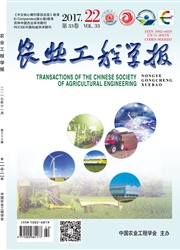

 中文摘要:
中文摘要:
现有研究以及关注的过滤设备多集中于低含砂水水源,对于缺水地区以高含砂水为水源进行微灌的研究较少,该文提出一种新型微灌用网式一体化水砂分离器,并与常规水砂分离器进行试验对比分析,旨在解决以高含沙水为水源进行微灌的堵塞问题。该文在试验对比的基础上,分别计算网式一体化水砂分离器和常规水砂分离器的主要性能参数,包括溢流参数(溢流流量和溢流浓度)、底流参数(底流流量、底流浓度、底流分流比)以及分级分离参数(分离效率和分级效率)。结果表明,网式一体化水砂分离器和常规水砂分离器的溢流流量和底流流量均与进口压力呈正相关关系,而底流分流比与进口压力呈负相关关系;在进口压力为0.26~0.34 MPa时,网式一体化水砂分离器的分割粒度为20.0~25.0μm,分离极限为83.5~89.0μm,分离精度为0.40~0.43;而常规水砂分离器的分割粒度为24.5~27.5μm,分离极限为86.0~95.0μm,分离精度为0.27~0.42。如果以分离效率80%为评价指标,在进口压力为0.26~0.34 MPa时,常规水砂分离器的平均分离粒径为65μm,而网式一体化水砂分离器的平均分离粒径为45μm。研究可为高含砂水微灌用新型过滤器提供了试验方法、试验参数和理论依据。
 英文摘要:
英文摘要:
Hydrocyclone separator is one kind of filtration equipment that can separate the sediment from high silt content water by using the principles of rotational flow and centrifugal force. In recent years, research on hydrocyclone separator is mostly in the field of petroleum and chemical industry. Existing literature research and filtering equipment more focuses on low silt content water, but the study on high silt content water as micro-irrigation water source in water shortage areas is lack. This paper put forward a type of screen hydrocyclone separator for micro-irrigation, aimed to resolve the congestion problem of high silt content water as micro-irrigation water source. The screen hydrocyclone separator and conventional separator were compared through the experiment, which was done from October to December 2014 at the State Key Laboratory of Water Resources and Hydropower Engineering Science, Wuhan University. The experiment chose XLF200 screen hydrocyclone separator with the cylinder diameter of 200 mm, the water outlet diameter of 65 mm, the water inlet diameter of 50 mm, and the bottom outlet diameter of 50 mm. The experiment was designed for the screen hydrocyclone separator and conventional separator under the same condition, and took samples for overflow and bottom flow in different inlet pressure working conditions, and measured quantity of inlet flow, concentration of inlet flow, pressure difference of inlet flow and overflow, quantity of bottom flow, concentration of bottom flow, split ratio of bottom flow, quantity of overflow and concentration of overflow, so as to calculate respectively the separation efficiency and classification efficiency for the screen hydrocyclone separator and conventional separator. The results showed that the quantity of overflow and quantity of bottom flow increased with increasing the inlet pressure, but the split ratio of bottom flow increased with decreased inlet pressure for both the screen hydrocyclone separator and the conventional separator. 3 different working cond
 同期刊论文项目
同期刊论文项目
 同项目期刊论文
同项目期刊论文
 期刊信息
期刊信息
